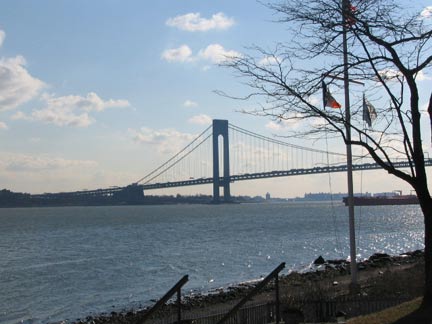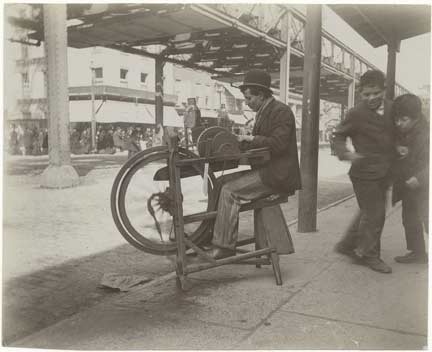In February 2005 I spent seven days in Staten Island. While many Manhattanites would consider that tantamount to a sentence to life without BlackBerries or having the Republicans in Madison Square Garden for a week again, I enjoyed the sojourn. I was there to obtain photos for the ForgottenBook, which came out in September 2006.

My home during that week was Harbor House, located at Hylan Boulevard and the aptly-named Edgewater Street in Rosebank. Staten Island’s longest street, Hylan Boulevard, begins and ends with 17th Century houses: Clear Comfort, which for many years was home to the eminent photographer Alice Austen, features an original section dating to as far back as 1691, while the Conference, or Billopp, House in Tottenville at the other end of Hylan, was built in 1680. It’s possibly the only main thoroughfare in the USA that begins and ends at 17th-Century buildings.
GOOGLE MAP: HYLAN BOULEVARD and EDGEWATER STREET


It was February, so every conceivable type of weather came up. The first night I was there, I did not sleep; I do not sleep well in a strange bed. I was forced to give up on it anyway at first light, when the roosters started crowing; as their efforts to chase the sun out of the sky failed, I set out on various trips that had me walking and bussing across the island for what must have been over a hundred miles.
It was a short walk to the Austen house from Harbor House and from its front lawn you had your choice of views of the Verrazano- Narrows Bridge…

…or the downtown Manhattan skyline…

…or the downtown Staten Island skyline.
was happiest, though, to be staying in a corner room, so I could gaze at both the harbor and at Clear Comfort; its wide lawn and elegant aspect was a soothing respite at a time when I was a little unsettled, being out of day-to-day work. Never mind that it was around 20 degrees just about every day I was there except the first, when it was about 60. I had known of the house’s historic aspect as the longtime home of Staten Island’s foremost photographer of the late 1800s and early 1900s, but until researching it I had no idea how old it was.


LEFT: Alice Austen is the picture of Victorian-era femininity in this 1888 protrait. Alice’s World, Ann Novotny
Alice Austen (1866-1952) was born to a prosperous family in what was then a part of Clifton and is now Rosebank. Her father, Edward Munn, disappeared before her birth; her mother, Alice Cornell Austen, moved with her daughter to her parents’ house, called Clear Comfort by the family, shortly after that. The house, at 2 Hylan Blvd. (then 2 Pennsylvania Avenue) had been purchased and later completely renovated from a simple farmhouse to a Victorian cottage by John Haggerty Austen, Miss Austen’s grandfather, in 1844.
Miss Austen was introduced to photography by her uncle, Oswald Müller, in 1876, when she was ten. Aside from Müller’s original demonstrations, her photographic skills and techniques were entirely self-taught, she insisted. In the latter years of the 19th Century, photography was a burdensome business; cameras were large and bulky, made of mahogany or cheaper wood with a leather cover. Negatives were produced on large glass plates covered with chemical emulsion and a number of these had to be carried, along with a selection of lenses, cartridges of magnesium powder, cables in case the photographe wished to insert herself in her own photographs, and tripods. More than one camera had to be taken, since in that era, larger cameras took larger prints; cameras could only take one proportion. As much as fifty pounds of equipment accompanied Miss Austen on her journeys. She maintained her own darkroom, spending many hours indoors processing her photographs.


Alice Austen, from New York Public Library Digital Gallery
Her subjects ranged from her family and friends on Staten Island, engaging in all manner of activities from lawn tennis, bicycling, beach outings, and costume parties (her pictures certainly negate the common image of the Victorian woman passively sipping tea indoors!). While in Manhattan, she captured images of newsboys and newsgirls, pushcart vendors, bootblacks, organ grinders, and rag pickers, subjects you would not expect a woman of privilege to entertain. Miss Austen traveled frequently, all over the east coast, Pennsylvania, Chicago, and Europe. She loved to capture the constant parade of ships that passed in clear view in the Narrows, just beyond her front lawn. (She would have loved to photograph the construction of the Verrazano-Narrows Bridge.) Her work was intimate, personal, and while curious about its subjects, never intrusive or exploitative. Some of it was frank; she was unafraid to let down her hair and be photographed smoking, quite daring public activities for women in the 1890s.


Portrait of man with grinding wheel (from the looks of things that’s likely the 9th Avenue El); newsgirl and newsboy, likely City Hall area. Alice Austen, from New York Public Library Digital Gallery
Alice Austen rarely posed her subjects in an era when stiff, formal postures were the norm. It can be said that she was among the first photojouralists. Unlike the great women photographers who were contemporaries or followed her in the 20th Century, Berenice Abbott, Jessie Tarbox Beals, Margaret Bourke-White, or Diane Arbus (and forgive me if I left anyone out), Miss Austen never thought about selling any of her work. She never had to, since her family was wealthy and prominent. As the decades rolled on Miss Austen and her companion, Gertrude Tate, became the sole residents at Clear Comfort and settled into a comfortable life of dinner parties and gatherings; but the 1929 stock market crash relieved her of her life savings at age 63 after she had speculated unwisely on land out west. The women subsequently operated an unsuccessful tea room and Gertrude ran a dance class for youngsters to no great profit. By 1945 the women were forced to sell their possessions and move out of the house that had been home to Miss Austen’s family for over 100 years.

Man with wheelbarrow on St. Johns Avenue near her home. Alice’s World, Ann Novotny

Tennis at Fort Wadsworth battery. Alice’s World, Ann Novotny
 Her final years were an uncomfortable time, with Miss Austen living in one nursing home or another but always having to move due to inability to pay. In 1950, at age 84, she was admitted to the poorhouse…the Staten Island Farm Colony, now in ruins at the center of the island. Toward the end, however, she received some welcome recognition for her decades of photographic expertise.
Her final years were an uncomfortable time, with Miss Austen living in one nursing home or another but always having to move due to inability to pay. In 1950, at age 84, she was admitted to the poorhouse…the Staten Island Farm Colony, now in ruins at the center of the island. Toward the end, however, she received some welcome recognition for her decades of photographic expertise.
LEFT: Alice Austen in 1951


When she was forced to move from Clear Comfort in 1945, Miss Austen called on an old friend, Loring McMillen of the Staten Island Historical Society, for assistance. McMillen was able to rescue some cardboard boxes in the basement containing 3,500 glass plate negatives: these comprise the collection of Miss Austen’s photographs we have today. A young writer, Oliver Jensen, published several of Miss Austen’s pictures in Life and Holiday in 1951, and the proceeds from the sale allowed her to move into a more comfortable nursing home, where she remained until her death in 1952. In October 1951 she had attended an exhibition of her life’s work at Historic Richmond Town.
In 1985 Clear Comfort was refurbished as a museum, to the way it appeared in Miss Austen’s day. Hundreds of her pictures, of course, are on display. The house is open from Thursday to Sunday in spring, summer and fall. Call (718) 816-4506.
SOURCES:
Alice’s World, Ann Novotny, Devin-Adair, 1976. Indispensible guide to Alice Austen, her times, her work and home at Clear Comfort.
BUY this book at Amazon.COM
Alice Austen House, a National Historic Landmark
4/22/2006




